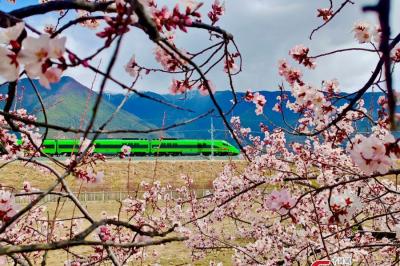| Dec. 29, 2017 -- Experts are calling for transnational cooperation between India and China to ensure sustained release of water from three barrier lakes formed along Yarlung Zangbo River after a series of earthquakes hit the region since last month.
As a result of the natural disasters, these lakes are threatening to burst endangering lives of hundreds of villagers residing downstream.
A 6.4-magnitude earthquake on November 17 was followed by a swarm of quakes with the epicenter near the great bend – world's highest gorge – from where Yarlung Zangbo River takes a U-turn.
The earthquakes triggered landslides blocking the river stream at various points resulting in those barrier lakes. The massive landslides have also polluted the river also known as Siang River in northeastern states of India.
Nayan Sharma, a river expert from Indian Institute of Technology, Roorkee, told CGTN that the barrier lakes are likely to burst once the temperature starts to rise in the region.
"Both India and China should form a team of transnational experts to ensure easy release of water from the artificial lakes else it will lead to human casualties and large-scale destruction," Sharma said.
A similar landslide incident in April 2000 had killed around 30 in one of India's northeastern state and left more than 1,000 families homeless. Sharma added that China's response to the crisis is encouraging, and both sides should jointly work to resolve the crisis.
Chinese Foreign Ministry spokesperson Hua Chunying said on a press conference on Tuesday, "China remains in contact with the Indian side through existing channels on the issue concerning cross-border rivers."
The landslides have led to substantial sediment load in the Siang River turning its water black. The debris from the mountains and silt polluted the river to the extent that Nephelometric Turbidity Unit – a measure of the concentration of suspended particulates in a liquid went up to 425.
The permissible turbidity for drinking water is around 5, a report by an Indian government laboratory claimed.
A few Indian politicians and a section of the media there had blamed Chinese dams and infrastructure construction for polluting the river.
Ripun Bora, a senior politician, and member of India's upper house of Parliament, the Rajya Sabha, accused China's massive infrastructure construction near the river for turning the river's water poisonous. |
- Home
- News Tibet |Exclusive |China |World |Related News |Latest
- Documents White Papers |Others
- Photo Politics |Economy & Society |Culture & Religion |Human & Nature |Beautiful Tibet |Other Tibetan-Inhabited Area |Exchanges |Related
- Video News |Documentary |Micro-Video |Entertainment
- Art
- Tourism
- In Focus
- About Tibet






